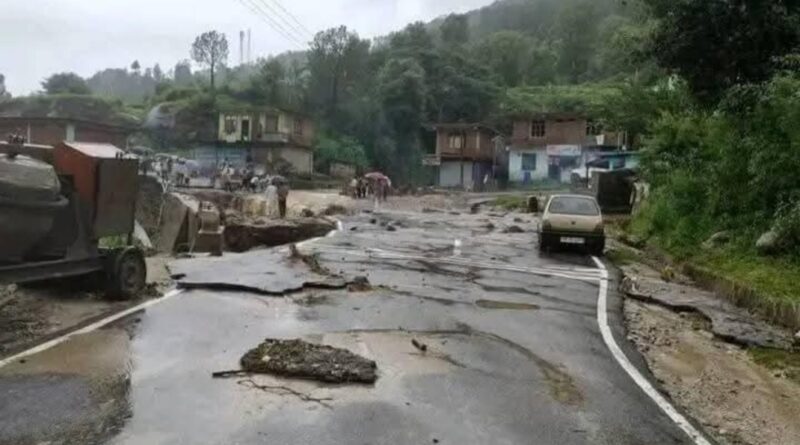People for Himalaya campaign urges NDMA to reform disaster governance in Himalaya’s
Over thirty organisations and forty individuals from across the Indian Himalayan Region have submitted a joint representation to the High Powered Committee of the National Disaster Management Authority (NDMA), calling for urgent reforms in disaster governance and climate preparedness. The statement, issued under the banner of the People For Himalaya campaign, comes in the wake of the catastrophic monsoon disasters of 2025 that exposed the deep ecological fragility and governance failures across the mountain states.
The submission notes that the 2025 monsoon season has brought widespread devastation through floods, landslides, glacial lake outburst floods, and cloudbursts across Uttarakhand, Himachal Pradesh, Ladakh, Jammu & Kashmir, the Northeast, and Darjeeling. These disasters have resulted in extensive loss of lives, destruction of homes, and collapse of infrastructure, while also laying bare the cumulative effects of unscientific development, environmental degradation, and decades of policy neglect in addressing mountain-specific vulnerabilities.
The signatories argue that the scale and frequency of such events demand a decisive and coordinated response from both national and state authorities.
The People For Himalaya campaign has called on the NDMA to immediately strengthen post-disaster needs assessment and financial support to affected states. It emphasises that Post-Disaster Needs Assessment (PDNA) studies already underway in states such as Uttarakhand and Himachal Pradesh must be completed without delay to guide fair and evidence-based rehabilitation and reconstruction. In regions where such assessments have not yet begun, such as Darjeeling and other parts of North Bengal, the submission urges the central government to constitute expert teams and launch detailed studies of the social, environmental, and livelihood impacts of disasters.
The statement calls for a substantial increase in allocations to State Disaster Response Fund to reflect the complex and escalating risks in the Himalaya, and recommends the creation of a dedicated disaster mitigation and climate adaptation fund for mountain states, with mechanisms for transparency and public accountability.
A central concern raised by the submission is the need to address the role of large-scale infrastructure projects in heightening disaster vulnerability. It points out that regions with extensive construction of highways, hydropower projects, tunnels, and railways have suffered the worst impacts, as these projects disrupt riverbeds, destabilise slopes, and cause deforestation. The campaign demands that all ongoing and proposed mega projects undergo an independent and scientific review to assess their cumulative ecological and disaster risks. It also calls for a halt to projects that increase exposure and vulnerability in fragile terrain, stricter regulation of tourism and commercial infrastructure, and the integration of climate change projections into all planning processes.
The submission reiterates the need to restore community consent in environmental decision-making and withdraw the recent Forest Conservation Act amendment that permits forest clearance within 100 kilometres of international borders.
The signatories have also highlighted the urgent need to fast-track rehabilitation and land rights for displaced populations. Given that nearly two-thirds of the land in Himalayan states is legally classified as forest, they argue that this legal constraint has made it extremely difficult to identify safe land for resettlement. Thousands of disaster-affected families, especially from marginalised and landless communities, continue to live in uncertainty and distress. The campaign urges authorities to ensure fair compensation, secure relocation, and restoration of livelihoods with particular attention to the needs of women, landless labourers, and pastoral and tribal groups. It also recommends time-bound exemptions under the Forest Conservation Act for treating disaster-affected lands, alongside ecological restoration measures.
The submission calls for institutionalising science-based planning and strengthening local governance. It urges the central government to enhance the technical and financial capacity of State Climate Change Cells to conduct micro-level vulnerability and risk assessments that can guide district-level planning. It further calls for expanding the monitoring networks of the India Meteorological Department and the Central Water Commission, enforcing strict zoning regulations in ecologically sensitive areas, and improving early warning systems and inter-agency coordination. The campaign underscores the importance of devolving authority to local governance institutions such as Panchayats and Gram Sabhas to build resilience through community-led monitoring and preparedness, integrating both scientific and indigenous knowledge systems.
The People For Himalaya campaign stresses that the Himalayan disasters of 2025 must mark a turning point in India’s approach to disaster governance. The statement concludes that the only viable path forward is one that centres safety, equity, and environmental integrity, supported by adequate funding, scientific planning, and empowerment of mountain communities.
The joint submission has been endorsed by thirty-one organisations and thirty-seven individuals across India and abroad, including Climate Front (Jammu), Citizens for Green Doon (Uttarakhand), Social Development for Communities Foundation (Uttarakhand), Joshimath Bachao Sangarsh Samiti (Uttarakhand), Himdhara Collective (Himachal Pradesh), Himalay Niti Abhiyan (Himachal Pradesh), The Shimla Collective (Himachal Pradesh), Council for Democratic Civic Engagement (Sikkim), Youth For Himalaya, Indigenous Perspectives (Imphal), Uttarakhand Lok Vahini (Uttarakhand), National Alliance of People’s Movements (NAPM), and MAUSAM Network.



